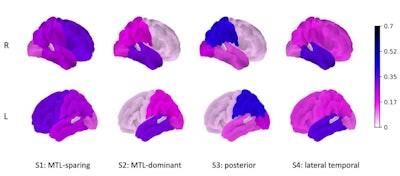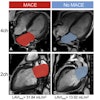
The four Alzheimer's disease subtypes can be identified by a computational method that incorporates genomic and tau PET imaging data, according to a study presented at the annual Society of Nuclear Medicine and Molecular Imaging (SNMMI) meeting.
Researchers led by Joyita Dutta, PhD, of the University of Massachusetts, developed an image-guided subtyping technique based on a novel clustering framework using sparse canonical correlation analysis (SCCA). In testing, their approach was able to differentiate the four subtypes, as well as to identify their top genes.
"By identifying different subtypes of Alzheimer's disease using both imaging and genomic information, researchers could gain potential new insights into the underlying biology of the disease and its progression," said Dutta, an associate professor in the university's department of biomedical engineering, in a statement from the SNMMI. "Understanding the specific genetic associations for each subtype could also lead to the development of personalized treatment approaches in the future."
The researchers utilized imaging and genomics data from 541 participants in the Alzheimer's Disease Neuroimaging Initiative (ADNI) who had received F-18 flortaucipir PET and Illumina single nucleotide polymorphisms (SNP) genotyping. Of these 541 participants, 334 were cognitively normal and 207 were cognitively impaired.
 Right and left hemisphere brain surface plots showing the strength of the canonical vector, for each subtype. Image and caption courtesy of Joyita Dutta, PhD, and the SNMMI.
Right and left hemisphere brain surface plots showing the strength of the canonical vector, for each subtype. Image and caption courtesy of Joyita Dutta, PhD, and the SNMMI.Right and left hemisphere brain surface plots showing the strength of the canonical vector, for each subtype. Image and caption courtesy of Joyita Dutta, PhD, and the SNMMI.
Tau PET standardized uptake value ratios were computed from 10 broad regions. In addition, SNP genotyping identified and extracted 145 genome variations. Next, the researchers jointly applied their SCCA-clustering framework to both the tau PET and genomics datasets.
The method identified medial temporal lobe (MTL)-dominant, posterior, MTL-sparing, and lateral-temporal subtypes of Alzheimer's disease. It also identified the top genes associated with each subtype, in addition to the apolipoprotein E gene (APOE) gene.
"Genomics- and imaging-guided individualized subtyping is vital for Alzheimer's disease because different subtypes may also have distinct rates and profiles of cognitive decline, potentially affecting clinical trial outcomes and treatment response," Dutta said. "By combining molecular imaging information with genomics, we have created a diagnostic technique that could be truly personalized for each patient. This has potential for broad diagnostic utility across many disease types, not only Alzheimer's disease."




















